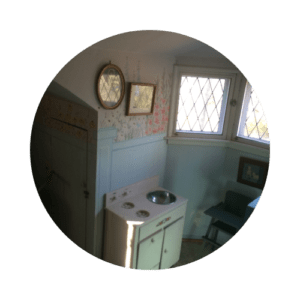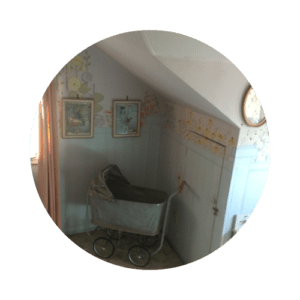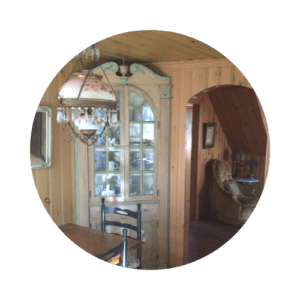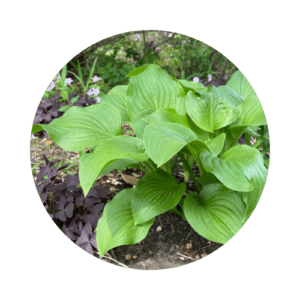If the alcove window had announced no cousins yet, I’d slip down the hall to visit the only other upstairs room, the playroom—bright and sunny, with a low-sloping ceiling and turreted punch-out whose latticed bay windows also overlooked the front lawn. Grandma had painted the space to suggest we were enclosed in a secret garden, or rather, because the flowers were on the far side of the fence, that we were about to enter the secret garden.
The walls were painted in striped light blue-gray pickets rising almost to the low ceiling. Bright flowers filled the narrow gap between—pink foxgloves, climbing roses, unknown flowers in exuberant clusters of yellow and blue. The linoleum floor imitated flagged stone. Five tiny doors—some locked with small golden padlocks guarding who knows what treasure, others opening on shelves full of playthings—were built into the striped and flowered walls.

The corners were full of vintage toys. A white wooden kitchen set with real knobs that turned while its burners were only painted on, had, as a sink, a shiny metal bowl whose rim held it in place above a hole cut for that purpose; a bright spray of flowers were lacquered above its cabinet and bread drawer. The small kitchen table was set with tin dishes printed with Mother Goose characters; a rosy-cheeked Humpty Dumpty stands out in my memory.

A large bin held play clothes—I particularly remember a robe in rippling folds of embroidered and deeply green silk, a purple and white polyester dress that belonged firmly to the 1960s, and those fabulous, sparkling ruby red slippers. A perambulator, oversized in the small room, held two plastic dolls that I remember standing to my waist, one blonde and the other dark. My older sister and I often would take them down to the lake with us to wash their hair from the dock.
Overlooking the garden and the toys, two pictures captured and enhanced the enchantment of the playroom. The first was a print of a prince, feather cocked jauntily in his hat, scaling a stone tower to Rapunzel’s window, his feet pressing against the gray stones, his hands wrapped in Rapunzel’s golden hair. The second, an image of a prince in a rose-filled tower room leaning over Sleeping Beauty, about to bring her to life. The princes blended into one in my mind as did their tower and my turreted playroom. Held within a secret tower garden, guarded by hostas rather than roses, I would unlatch and swing the leaded windows open to wait, not for a prince but for the key to the magic.

Soon, a rumbling would sound along the driveway and I’d rush downstairs, magic lost in the joy of cousins. There were many hugs in the round, turreted entry way. In this space were some of Grandma’s few concessions to the practical—an old mustard-yellow rotary telephone and a framed list of important numbers on a little shelf in the entry. Bright orange cans of bug spray. Blue plastic cases of fishing tackle. A black rubber rug to wipe mud from our feet.
And there was Mom in the small but sunny yellow kitchen, doling out cereal and orange juice, directing us to the right cupboards and drawers for dishes and spoons. We’d eat in shifts at the dining room table or more often spill outside to the picnic tables and benches, and one of us might even try to balance on the swing, cereal bowl on knee.
The dining room table was covered in a blue plastic cloth—another concession to the practical—and surrounded by four simple black shaker-style chairs. Above the table hung an intricate brass light fixture, its cream glass globes painted with scrolling roses and surrounded by dangling crystals that connected it to the adjoining great room’s grand chandelier. Tucked into a corner, beside the doorway to the great room, stood a mystery—a glass-doored corner hutch that appeared to have been—must have been—built into the cabin.
Its creamy-white stain and fresh green detailing, the charming collection of mismatched dishes and fairy figurines inside the rounded glass doors, and the daisy sprays painted on its lower cabinet doors all looked so unassuming. But at its height, a round-topped finial fit exactly into a groove in the tongue-and-groove knotty pine paneled ceiling.
It didn’t really look original to the cabin. It didn’t quite fit the style the builder would have used, I thought; it was too light and airy. Yet it fit the physical dimensions of the space exactly. I would study that sphere, wondering how it could possibly have been brought there. I don’t think a piece of paper could have been slipped between it and the grooved ceiling. On the wall across from me as I pondered this riddle was a picture of children peering into a birdcage. The awe and mystery in their faces mirrored mine as I contemplated the machinations required to bring in the hutch that appeared to have been—must have been—built into the cabin.

If I didn’t land a spot at the dining room table, I’d beeline it to the shaded bench curving around the base of a maple overlooking the lake below, obscured as it was in the exuberance of summer foliage. The bench, a tiled geometric mosaic in cerulean blues, greens, yellows, oranges, reds, always evoked the Oriental, suggesting the magic of Scheherazade and augmenting the sense of entering a new realm while at the cabin. The tiles, smooth and silky beneath my fingers, pressed into my bare legs as I sat and pondered—one foot in the world of Styrofoam and Cheerios, the other in a tale of deeply layered magic spanning ages and epics and worlds.
Behind me grew the maple that seemed larger than life, its lowest branches higher than any could reach. From one thick limb swung the ropes of a swing that my uncle had hung many years ago. Its notched wooden seat rested on the loop of rope, and over the years held each one of us as we pumped away from earth. From the heights of the swing I surveyed the concentric rings creating and encircling the enchantment—the overgrown woods, the mossy glade, the low garden walls bordering thickly planted hostas, the moss-covered, lichen encrusted stone walls rising to turrets and towers.
A lamppost rose from a stone pillar along the path to the door at the corner of the low garden wall. Before the hostas, at the pillar’s base, a red-capped gnome stood guard. The lone lamppost suggested Narnia in its youth, Narnia in summer—a world verdant and blessed, its creation song still echoing in the living stone.

Rachel Brown
enjoys sipping tea, savoring good books, and spending time outside.
She is daily inspired to live more deeply and love more fully by her husband and two children.
